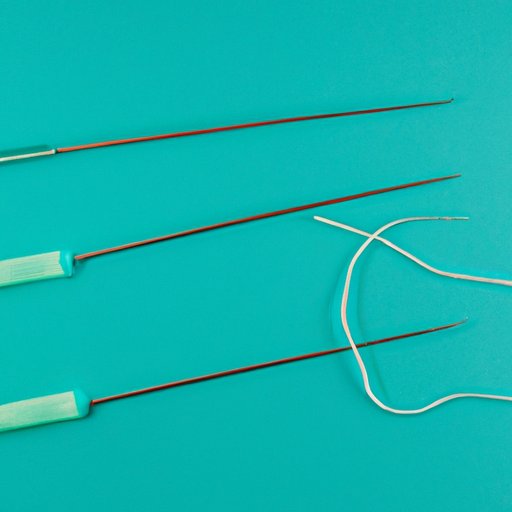
I. Introduction
If you are a healthcare professional or work in an industry that involves handling needles, it is essential to know how to safely use an eclipse safety needle. An eclipse safety needle is a type of needle that is designed to reduce the risks of needlestick injuries and infection transmission. In this article, we will provide you with a comprehensive guide on how to use an eclipse safety needle properly, why it is crucial to do so, tips for training, and the potential benefits and drawbacks of using these needles.
II. A Step-by-Step Guide on How to Use an Eclipse Safety Needle
Firstly, it’s essential to understand what an eclipse safety needle is and how it works. An eclipse safety needle comes with a mechanism that can retract the needle back into the safety cover upon completion of the injection, leaving the needle shielded safely. This mechanism helps prevent accidental needlestick injuries and exposure to bloodborne pathogens. Here are the steps to using an eclipse safety needle safely:
– Once you have prepared the medication, remove the needle cap by twisting or pulling it away from the needle hub.
– Hold the syringe barrel and screw the needle onto it. Ensure it is tight enough not to detach from the syringe.
– Administer your injection as usual, while maintaining proper hand hygiene.
– Once the injection is complete, remove the needle from the injection site, and immediately activate the safety mechanism. For most models, this is done by placing the thumb or finger on the safety cover and pressing the device firmly against a flat surface.
– Check that the safety shield has locked into place, rendering the needle inaccessible.
It’s worth noting that taking shortcuts when administering injections and carelessly operating the needle increases the risk of needlestick injury. Therefore, following these steps to the letter is crucial to minimizing the risks.
III. The Importance of Properly Using an Eclipse Safety Needle
Using an eclipse safety needle properly is a vital step in reducing the risks of needlestick injuries and infection transmission. Infections can occur when using contaminated needles and cause diseases like HIV, Hepatitis, and sepsis. But it’s not just patients that are at risk. Healthcare professionals also face a significant risk of needlestick injuries, which can lead to physical, emotional, and financial burdens.
To use an eclipse safety needle correctly, follow these tips:
– Always hold the needle by the hub and keep the needle tip pointing away from your body.
– Avoid recapping used needles manually, as this is a leading cause of accidental needlestick injuries.
– Always activate the safety feature after using the needle, even if the needlestick injury hasn’t occurred.
– Dispose of used needles properly, following local regulations and guidelines.
IV. Frequently Asked Questions About Eclipse Safety Needles
Here are some of the commonly asked questions about using Eclipse safety needles that you might have:
Q: Can I still get a needlestick injury while using the Eclipse safety needle?
A: While Eclipse safety needles can reduce the risk of accidental needlestick injuries, it’s still possible to get one if you are not careful when handling the used needles.
Q: Are Eclipse safety needles more expensive?
A: Yes, Eclipse safety needles are generally more expensive than regular needles. However, this cost is minimal compared to the potential costs of needlestick injuries and infection transmission.
Q: How do I dispose of used Eclipse safety needles?
A: Local regulations often dictate the proper disposal of used needles. Typically, healthcare settings offer sharps containers in which you can dispose of used needles.
V. Tips for Training on the Use of Eclipse Safety Needles
Proper training on the use of Eclipse safety needles is essential to ensure safety and effectiveness. If you are a trainer or healthcare professional responsible for training others on needle safety, consider the following tips:
– Provide a step-by-step guide on how to use the needles correctly, accompanied by illustrations where appropriate.
– Stress the importance of safe needle handling, proper disposal, and the consequences of failing to follow safety protocols.
– Encourage trainees to participate in hands-on training sessions to get a feel for the needles.
VI. The Benefits and Drawbacks of Using Eclipse Safety Needles
Using Eclipse safety needles comes with several benefits, including:
– Reducing the risk of needlestick injuries and bloodborne pathogen exposure.
– Reducing the number of needlestick injuries and subsequent workers’ compensation claims.
– Providing peace of mind for both healthcare professionals and patients.
However, there are also potential drawbacks, such as the cost of acquiring the needles, concerns around proper disposal, and the potential for the safety mechanism to malfunction. These drawbacks, however, are negligible when compared to the potential risks of failing to use the needles properly.
VII. Conclusion
Properly using Eclipse safety needles is crucial to minimize the risks of needlestick injuries and infection transmission. It’s essential to follow the step-by-step guide provided in this article, properly train others, and dispose of used needles in line with local regulations. While there may be some drawbacks to using Eclipse safety needles, they are far outweighed by the benefits. With the right knowledge and training, you can help ensure that you and those around you remain safe and healthy.




